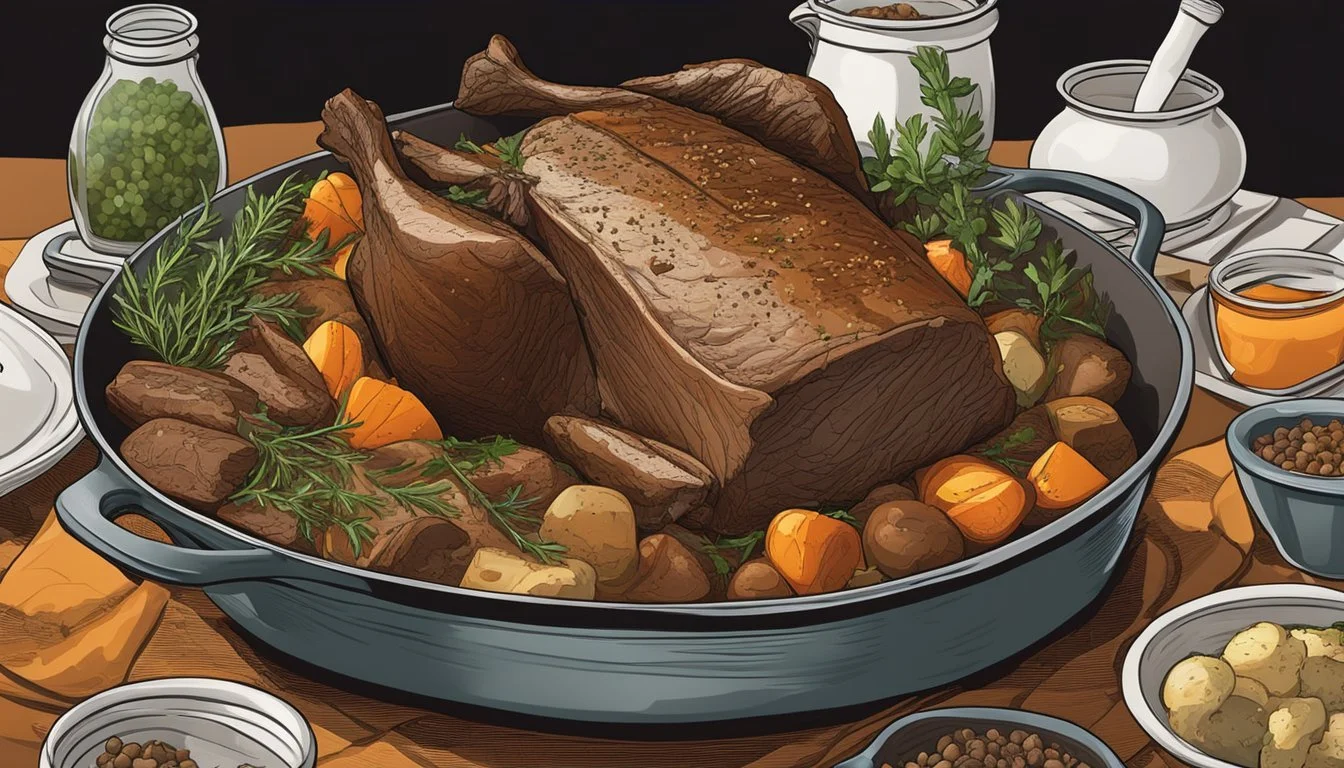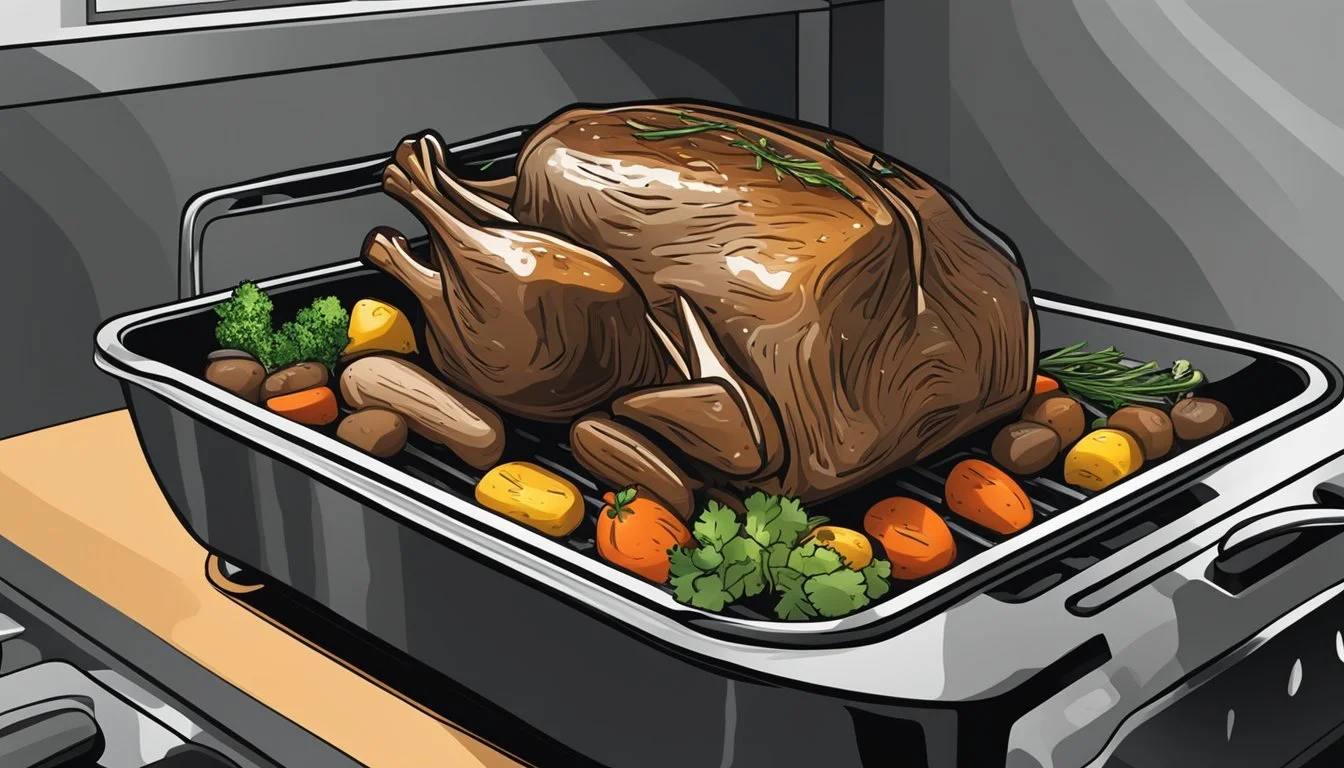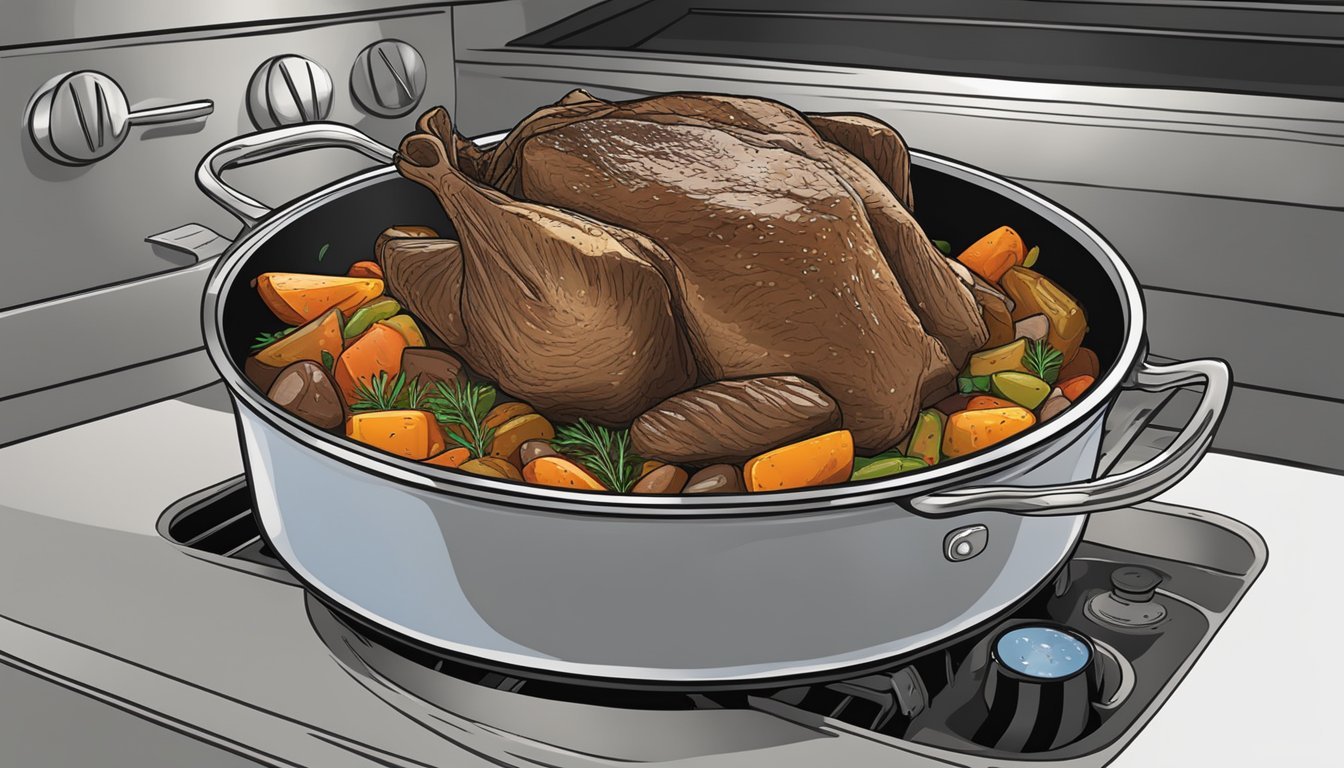How to Cook a 3 lb Pot Roast in the Oven
Tender and Flavorful Results
Pot roast is a classic comfort food that brings families together around the dinner table. This hearty dish transforms a tough cut of beef into tender, flavorful meat through slow cooking in the oven. A 3-pound pot roast typically requires about 3 to 3.5 hours of cooking time at 325°F (163°C) to reach the desired fall-apart texture.
Preparing a perfect pot roast involves a few key steps. The meat should be seasoned generously with salt and pepper, then seared in a hot pan to develop a flavorful crust. Vegetables like onions, carrots, and potatoes are often added to create a complete meal. The roast is then braised in liquid, such as beef broth or red wine, which helps keep the meat moist and infuses it with rich flavors.
Selecting the Perfect Cut
Choosing the right cut of beef is crucial for a delicious pot roast. A well-selected cut will result in tender, flavorful meat that falls apart with ease.
Understanding Beef Cuts
Chuck roast is often considered the gold standard for pot roasts. It comes from the shoulder area and contains a good balance of meat and fat. Rump roast and bottom round are leaner options from the rear of the animal. These cuts can be flavorful but may require longer cooking times.
Shoulder roast is another excellent choice, similar to chuck roast in texture and flavor. Each cut has its unique characteristics, influencing cooking time and final taste.
Marbling and Tenderness
Marbling refers to the white lines of fat within the muscle tissue. More marbling typically leads to a juicier, more flavorful roast. Look for cuts with visible marbling throughout.
Tougher cuts with more connective tissue, like chuck roast, are ideal for pot roasts. These cuts contain collagen, which breaks down during slow cooking, resulting in tender meat.
When selecting a cut, consider:
Amount of marbling
Presence of connective tissue
Overall fat content
A well-marbled, tough cut of beef will transform into a tender, flavorful pot roast after slow cooking in the oven.
Preparing the Ingredients
Proper ingredient selection and preparation are crucial for a delicious pot roast. Fresh, high-quality components will elevate the dish's flavor and texture.
Sourcing Fresh Produce
Choose firm, brightly colored vegetables for the best results. Select medium-sized yellow or white onions with dry, papery skins. Look for crisp carrots with vibrant orange hues. Pick potatoes that are firm and free from sprouts or green spots. Opt for celery stalks that are crisp and pale green.
Fresh garlic cloves should be plump and tightly closed. Avoid any with soft spots or signs of sprouting. For herbs, select bunches with bright green leaves and no wilting or discoloration.
Herbs and Seasonings
A well-seasoned pot roast relies on a blend of herbs and spices. Essential seasonings include kosher salt, black pepper, garlic powder, and onion powder. Fresh herbs like rosemary and thyme add aromatic depth.
Bay leaves contribute a subtle, earthy flavor. Consider adding dried oregano for a Mediterranean touch. Experiment with different combinations to find your preferred flavor profile.
Store dried herbs and spices in airtight containers away from heat and light to maintain their potency.
Prep Work
Begin by washing all vegetables thoroughly under cool running water. Peel and quarter the onions. Cut carrots and celery into 2-inch pieces. Cube potatoes into 1-inch chunks.
Mince fresh garlic cloves or use a garlic press for convenience. Strip fresh herb leaves from their stems and chop finely. Measure out dried herbs and spices into small bowls for easy access during cooking.
Pat the roast dry with paper towels to promote better browning. Trim excess fat if desired, leaving a thin layer for flavor and moisture.
Preheating and Searing
Proper preheating and searing are crucial steps for creating a flavorful pot roast. These techniques set the foundation for a delicious meal by developing a rich crust and sealing in juices.
Optimal Oven Temperature
Preheat the oven to 325°F (163°C) for cooking a 3 lb pot roast. This moderate temperature allows for slow, even cooking that tenderizes the meat without drying it out.
Place the oven rack in the lower third of the oven to ensure even heat distribution around the roast. Use an oven thermometer to verify the temperature accuracy.
Allow 15-20 minutes for the oven to fully preheat before placing the roast inside. This ensures consistent cooking from start to finish.
The Searing Process
Searing creates a flavorful browned crust on the exterior of the pot roast. Heat a large, oven-safe skillet or Dutch oven over medium-high heat. Add a small amount of oil with a high smoke point, such as canola or vegetable oil.
Pat the roast dry with paper towels to promote better browning. Season the meat generously with salt and pepper.
Place the roast in the hot skillet and sear for 3-4 minutes per side until well-browned. Use tongs to turn the meat, avoiding piercing it with a fork which can cause juice loss.
Once seared, transfer the skillet with the roast directly to the preheated oven to begin the slow cooking process.
Cooking Techniques
Mastering the right techniques is crucial for a tender, flavorful 3 lb pot roast. Key methods include braising, incorporating liquids, and using a Dutch oven.
Braising Basics
Braising involves searing the meat to develop a flavorful crust, then cooking it slowly in liquid. Start by seasoning the roast with salt and pepper. Heat oil in a large, oven-safe pot over medium-high heat. Sear the roast for 3-4 minutes per side until browned.
Remove the roast and set aside. Add aromatics like onions and garlic to the pot, cooking until softened. This creates a flavorful base for the braising liquid.
Return the roast to the pot. The slow cooking process breaks down tough connective tissues, resulting in tender meat. Typical braising time for a 3 lb roast is 2.5-3 hours at 325°F (163°C).
Incorporating Liquids
The right liquids enhance flavor and ensure moisture. Beef broth is a classic choice, providing rich, meaty undertones. For depth, add 1/2 cup of red wine. This not only imparts flavor but helps tenderize the meat.
Use enough liquid to come about 1/3 up the side of the roast. This allows for proper braising without submerging the meat. A good ratio is 2 cups of liquid for a 3 lb roast.
Consider these liquid combinations:
1.5 cups beef broth + 1/2 cup red wine
1 cup beef stock + 1 cup water
2 cups beef broth
Add vegetables like carrots and potatoes in the last hour of cooking to prevent overcooking.
Using a Dutch Oven
A Dutch oven is ideal for pot roast due to its heat retention and distribution properties. Its tight-fitting lid traps moisture, creating a moist cooking environment.
Preheat the oven to 325°F (163°C). After searing and adding liquids, cover the Dutch oven and transfer it to the preheated oven. The heavy lid prevents excessive evaporation, maintaining a consistent braising environment.
Check the roast every hour, basting with the cooking liquid. This helps keep the meat moist and flavorful. If the liquid reduces too much, add more broth or water.
For a 3 lb roast, start checking for doneness after 2.5 hours. The meat should be fork-tender when done.
Creating the Dish
Crafting a perfect pot roast involves layering flavors and combining components strategically. These steps ensure the meat becomes tender while vegetables and seasonings infuse the dish with rich taste.
Layering Flavors
Begin by seasoning the 3 lb chuck roast generously with salt and pepper. Heat olive oil in a skillet over medium-high heat. Sear the roast on all sides until browned, about 3-4 minutes per side. This step locks in flavors and enhances the meat's color.
In a roasting pan, create a bed of chopped onions, carrots, and celery. Place the seared roast on top of the vegetables. Add herbs like thyme and rosemary around the meat. Pour beef broth or wine into the pan, filling it about 1/3 of the way up the sides of the roast.
Combining Components
Cover the roasting pan tightly with a lid or aluminum foil. This traps moisture, allowing the meat to braise and become tender. Place the covered pan in a preheated oven set to 325°F (165°C).
Cook for approximately 3 hours, or until the meat is fork-tender. Halfway through cooking, add cubed potatoes around the roast. This timing allows the potatoes to cook without becoming mushy.
For a thicker gravy, remove the roast and vegetables once done. Strain the pan juices and simmer them on the stovetop with a mixture of flour and water until thickened. Serve the pot roast with vegetables and gravy for a comforting meal.
Monitoring and Finalizing
Proper monitoring and finishing steps are crucial for achieving a perfectly cooked 3 lb pot roast. These final stages ensure the roast reaches the ideal internal temperature and allows the meat to rest for maximum tenderness and flavor.
Checking Internal Temperature
Insert a meat thermometer into the thickest part of the roast to check its internal temperature. For medium doneness, aim for 145°F (63°C). The temperature will continue to rise slightly during resting.
For a more tender result, cook until the internal temperature reaches 160°F (71°C). This allows the connective tissues to break down further, resulting in a fork-tender texture.
Check the temperature periodically to avoid overcooking. If the roast is browning too quickly on the outside but hasn't reached the desired internal temperature, cover it loosely with foil.
Resting and Serving
Once the roast reaches the target temperature, remove it from the oven. Transfer the meat to a cutting board and tent it loosely with foil. Let it rest for 15-20 minutes.
During this resting period, the internal temperature will continue to rise slightly, and the juices will redistribute throughout the meat. This process ensures a juicier and more flavorful result.
After resting, slice the roast against the grain. Serve it as the main course alongside classic sides like mashed potatoes and roasted vegetables. Pour any accumulated juices over the meat for added flavor.
For optimal tenderness, consider using a fork to shred the meat if it's particularly tender. This works especially well for pot roasts cooked to higher internal temperatures.
Additional Cooking Methods
Pot roast can be prepared using various cooking methods beyond the traditional oven technique. Each method offers unique benefits and flavors while still delivering a tender, succulent roast.
Slow Cooker Adaptation
Slow cookers are ideal for cooking pot roast, providing a convenient, hands-off approach. Place the 3 lb roast in the slow cooker with vegetables, broth, and seasonings. Cook on low for 8-10 hours or on high for 5-6 hours. This method results in an incredibly tender roast that falls apart easily.
The slow, steady heat allows the connective tissues to break down gradually, enhancing the meat's tenderness. Add vegetables like carrots, potatoes, and onions during the last 2-3 hours to prevent overcooking.
Stovetop Method
Cooking pot roast on the stovetop offers more control over the cooking process. Use a heavy-bottomed Dutch oven or large pot. Brown the roast on all sides over medium-high heat to develop a flavorful crust.
Add vegetables, broth, and seasonings, then simmer covered for about 3 hours or until the meat is fork-tender. Check occasionally and add more liquid if needed. This method allows for easy basting and adjusting of flavors throughout the cooking process.
Pressure Cooker Option
Pressure cookers significantly reduce cooking time while still producing a tender pot roast. Brown the roast in the pressure cooker using the sauté function. Add vegetables, broth, and seasonings.
Seal the cooker and cook on high pressure for about 60-75 minutes, depending on the roast's thickness. Allow for natural pressure release for 10-15 minutes before opening. This method is perfect for busy households, delivering a flavorful roast in a fraction of the time.
Enhancements and Variations
Elevating a classic pot roast involves creative marinades, rubs, and ingredient substitutions. These alterations can transform the dish while maintaining its comforting essence.
Marinades and Rubs
A marinade infuses the meat with flavor before cooking. Mix Worcestershire sauce, red wine, garlic, and herbs for a savory blend. Marinate the roast for 4-8 hours in the refrigerator.
Dry rubs offer an alternative flavor boost. Combine paprika, brown sugar, mustard powder, and dried herbs. Massage the mixture into the meat 30 minutes before cooking.
For a Mediterranean twist, use a paste of olive oil, lemon zest, rosemary, and thyme. This brightens the dish's profile.
Alternative Vegetables and Ingredients
Swap traditional carrots and potatoes for diverse options. Parsnips add a sweet, earthy flavor. Turnips or rutabagas provide a peppery note.
Fresh herbs enhance the aromatics. Rosemary, thyme, and sage create a fragrant blend. Add them in the last 30 minutes of cooking to preserve their flavors.
For a richer sauce, incorporate red wine or beef stock. These liquids deglaze the pan and intensify the gravy.
Mushrooms add umami depth. Sauté them separately and add to the pot in the final hour of cooking.
Storage and Reheating
Proper storage and reheating techniques are crucial for maintaining the quality and safety of leftover pot roast. These methods help preserve flavor, texture, and nutritional value while preventing foodborne illness.
Proper Storage Techniques
Store leftover pot roast promptly to ensure food safety. Refrigerate within two hours of cooking or one hour if the room temperature exceeds 90°F (32°C). Place the meat in airtight containers or wrap tightly in aluminum foil or plastic wrap. Divide large portions into smaller amounts for quicker cooling and easier reheating.
Refrigerated pot roast stays fresh for 3-4 days. For longer storage, freeze for up to 3 months. Label containers with the date to track freshness. When freezing, leave some space in the container for expansion.
To prevent freezer burn, remove as much air as possible from storage bags. Consider freezing pot roast with its gravy or broth to help maintain moisture during reheating.
Best Reheating Practices
Reheating pot roast requires care to preserve its tenderness and flavor. The oven method is often preferred for even heating and moisture retention. Preheat the oven to 250°F (121°C). Place the pot roast in an oven-safe dish and add a small amount of broth or gravy to maintain moisture.
Cover the dish tightly with foil to trap steam. Heat for about 20-25 minutes per pound of meat, or until the internal temperature reaches 165°F (74°C). Use a meat thermometer for accuracy.
For quicker reheating, the microwave can be used. Place sliced pot roast in a microwave-safe dish with some liquid. Cover and heat in 30-second intervals, stirring between each, until heated through.
A slow cooker offers another gentle reheating method. Add the pot roast with some liquid and cook on low for 2-3 hours. This method is ideal for larger portions or when serving time is flexible.
Troubleshooting Common Issues
When cooking a 3 lb pot roast in the oven, a few challenges may arise. Addressing these issues can help ensure a delicious and satisfying meal.
Dry or Tough Roast Solutions
To prevent a dry or tough roast, focus on moisture retention. Braising the meat in liquid can help keep it tender. Use a tight-fitting lid or cover the roasting pan with foil to trap steam.
Consider lowering the oven temperature and extending the cooking time. This slow-cooking method allows connective tissues to break down gradually, resulting in a more tender roast.
Resting the meat after cooking is crucial. Let it sit for 15-20 minutes before slicing. This allows juices to redistribute throughout the roast, enhancing moisture and flavor.
If the roast is already overcooked, slice it thinly and serve with gravy or au jus to add moisture.
Tackling Underseasoning
Proper seasoning is key to a flavorful pot roast. If the meat lacks flavor, there are several ways to enhance it.
Create a flavorful rub using salt, pepper, garlic powder, and herbs like thyme or rosemary. Apply this mixture generously to the roast before cooking.
Consider adding aromatic vegetables like onions, carrots, and celery to the roasting pan. These impart flavor to the meat as it cooks.
If the roast is already cooked and underseasoned, prepare a savory gravy using the pan drippings. Enhance it with additional herbs, spices, or a splash of wine for depth of flavor.
Serving the roast with a side of horseradish sauce or mustard can also provide a flavor boost.
Finishing Touches
As your pot roast nears completion, it's time to focus on the final elements that elevate the dish. These finishing touches transform the roast from a simple meal into a memorable dining experience.
Making Gravy from Pan Juices
Remove the roast and vegetables from the pan, leaving behind the flavorful juices. Place the pan on the stovetop over medium heat. Deglaze the pan by adding a splash of red wine or beef broth, scraping up any browned bits stuck to the bottom.
Whisk in 2 tablespoons of cornstarch mixed with 1/4 cup cold water. Stir constantly as the mixture thickens. For a smoother gravy, strain out any vegetable pieces.
Season the gravy with salt and pepper to taste. Add a pat of butter for richness and glossiness. If the gravy is too thick, thin it with additional broth. Too thin? Simmer it longer to reduce.
Garnishes and Presentation
Slice the fork-tender roast against the grain. Arrange the meat on a platter, surrounded by the roasted vegetables. Pour some gravy over the meat, reserving the rest for tableside serving.
Fresh herbs make an attractive and flavorful garnish. Sprinkle chopped parsley, thyme, or rosemary over the dish. For a pop of color, add a few sprigs of fresh herbs or thin lemon slices around the platter's edge.
Consider serving additional sides in separate bowls. Creamy mashed potatoes or buttered egg noodles pair well with pot roast. A crisp green salad provides a refreshing contrast to the rich main course.








